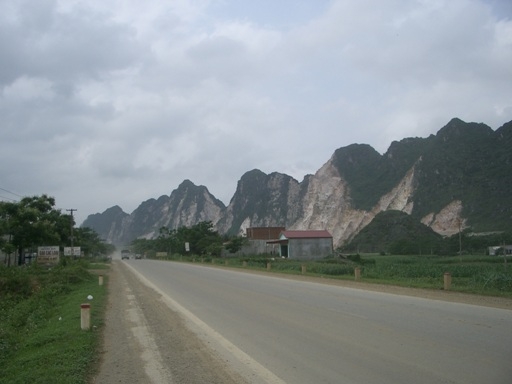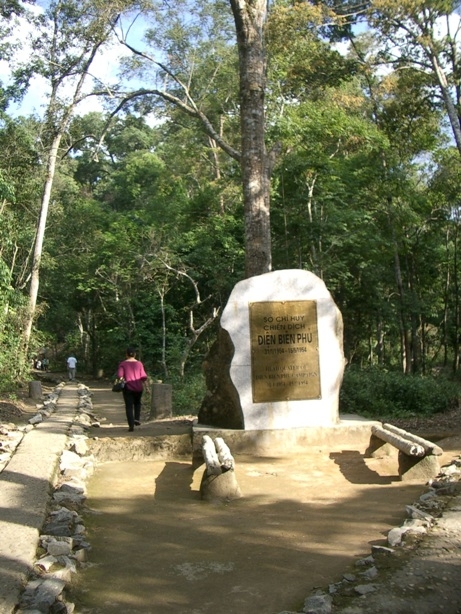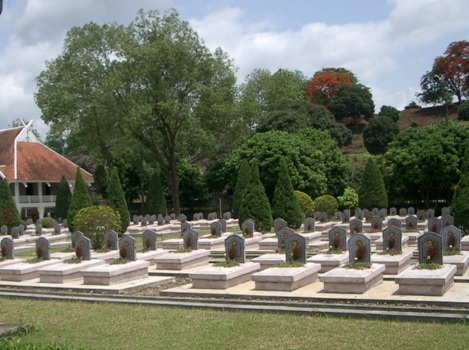 |
| Transporting goods along Ho Chi Minh trail to a Southern war zone in the 60’s |
 |
| New road replacing Ho Chi Minh trail |
 |
| General Giap’s headquarters |
 |
| Part of Dien Bien Phu’s cemetery, with tombs of unknown soldiers |
As we passed by a series of mountains along the Truong Son Range, I was told the Americans had dropped at least four million tons of bombs along the trail during the war. The numbers of Vietnamese deaths and wounded were also in the millions. Aside from Agent Orange, the Americans also sprayed other types of chemical defoliants. In addition, they created rain by seeding clouds, in turn producing mudflows -- attempting to destroy the jungle path.
It was in the 90's, when Prime Minister Vo Van Kiet authorized the construction of the entire trail with concrete materials. Its width was increased up to four times. The newly built road also became highly beneficial to tribal Hmong families as it enabled them to travel from the remote mountain sites to towns and cities. Many Hmongs could do direct trading with the Kinh people, which is the majority ethnic group in Vietnam.
After nearly four hours of smooth travelling and admiring the beauty of the wilderness, we arrived in Thanh Hoa. There, we attended the ceremony of the 100th day following the re-burial of the 22nd emperor of the Le dynasty, Le Du Tong, who had reigned from 1705 to1729. Like all the 27 Le emperors, Du Tong had been buried in a secret location in Thanh Hoa. Forty six years ago, when a farmer was digging up the soil, he accidentally un-earthed the emperor's tomb. The government decided to keep the remains inside the National History Museum in Ha Noi for research. When Du Tong was first buried in 1731, his body was embalmed and dressed in 13 layers of silk gowns containing preservatives. Finally, last spring he was returned to Thanh Hoa, with a grand ceremony. His new tomb will become one of the great memorial sites. To prepare for the second burial, the local authorities had to widen the village roads to allow the 400 cars and trucks into the site. On the date of the burial, many young children climbed up into the trees to watch the coffin being lowered into the ground. Overloaded with the children, many branches fell and broke. Miraculously, nobody was injured. The locals said the emperor had protected them.
The 100th day ceremony was scheduled to begin at 3pm. However, the monks had decided to wait for us as we did not arrive until 4pm. At this ceremony, I was given the rare honor to present a scroll written in calligraphy by a Buddhist monk containing my personal wish to the Emperor's spirit. He is called "the elder gentleman". Something strange would happen soon. In that same week, I was invited to Dien Bien Phu for the commemoration of the 56th anniversary of the Battle of Dien Bien Phu. The trip would take 4 days by road, with stopovers in Moc Chau and Lai Chau. The Deputy Minister of Foreign Affairs, Nguyen Thanh Son, would lead the group. I badly wanted to visit the great old battlefield. However, I had already scheduled another trip to the Mekong Delta, concerning my charity. It would not be possible for me to include Dien Bien Phu. While feeling the anxiety, I made a prayer to "the elder gentleman". To my pleasant surprise, the dates for Dien Bien Phu were suddenly changed and we would leave Ha Noi two days earlier. The revised departure date was perfect for me, as I would be able to make the trip to the Mekong Delta after returning from Dien Bien Phu. Did the "elder gentleman" answer my prayer or was it pure chance? In either case, I felt that some spiritual force had blessed me for having committed myself to the charity.
We left the burial site in the evening. On the way back to Ha Noi, we stopped at a little restaurant near a mountain site for dinner. The pleasant waitress served us charcoal grilled wild boar. This was accompanied by fried farmer chicken, steamed fish with green bananas, and boiled wild vegetables. That was an exceptionally delicious meal. We returned to the comfortable car and were driven smoothly along. I enjoyed listening to many heart-felt war songs. The long trail circling the Truong Son mountains was most serene and one could hear the whispering of the night wind. The sky was pitch dark: mysterious, calm, and melancholic.
My journey to Dien Bien Phu a few days later included another series of scenic routes and also rough and muddy roads. The group enjoyed various local cuisines, including wild boar and buffalo meat. Early morning the next day we arrived at a hilltop overlooking the old battlefield. The grand ceremony for the deceased soldiers was solemn and powerful. The event was organized by the Ministry of Foreign Affairs and the National Buddhist Association. Nearly 100 monks and nuns were present, with a huge crowd attending each day. The great altar was filled with many varieties of fresh fruits, prepared food, and drinks. Lots of beautiful orchids and chrysanthemums were on display. Together with other overseas Vietnamese, I visited the large cemetery of the unknown soldiers. At each tomb, we lit incense for the deceased. One of the most moving aspects of the whole occasion was the consideration shown to the soldiers on both sides of the war who had died for their countries. On our last day at Dien Bien Phu, we went up to General Vo Nguyen Giap's old headquarters on top of a very steep hill. Climbing was hard physical labor. I wondered about the task of pulling the many heavy cannons uphill. I thought of the thousands of Vietnamese, known and unknown, who had lost their lives at this battle. We owe them our way of life.
As soon as I returned from Dien Bien Phu, I made a second trip to Thanh Hoa, this time with Brooke Balza, an American documentary photographer. A devoted member of the charity, she wanted to obtain many photographs of the children victims of Agent Orange. They are of the third generation of those originally infected. Witnessing their physical deformity was most disturbing. With the photos, we will hold international exhibitions to raise money in order to build therapy and skill centres in Thanh Hoa and other provinces. During the American War, a large number of young men and women from Thanh Hoa had gone South to join the nationalist forces. Of these, at least 22,000 were infected by Agent Orange. Thanh Hoa itself had also suffered massive bombing raids. In the mid 60's, when the United States started their seven year campaign against North Viet Nam with "Operation Rolling Thunder", the Thanh Hoa Bridge was a strategic target for repeated attacks. So many B-52 bombers were shot down from this bridge that the proud local residents changed its name to "Dragon's Jaw Bridge".
I now anticipate many future trips to Thanh Hoa. And I would love to travel along the Ho Chi Minh trail again. One day I would like to go along the trail all the way to the Mekong Delta.

Không có nhận xét nào:
Đăng nhận xét